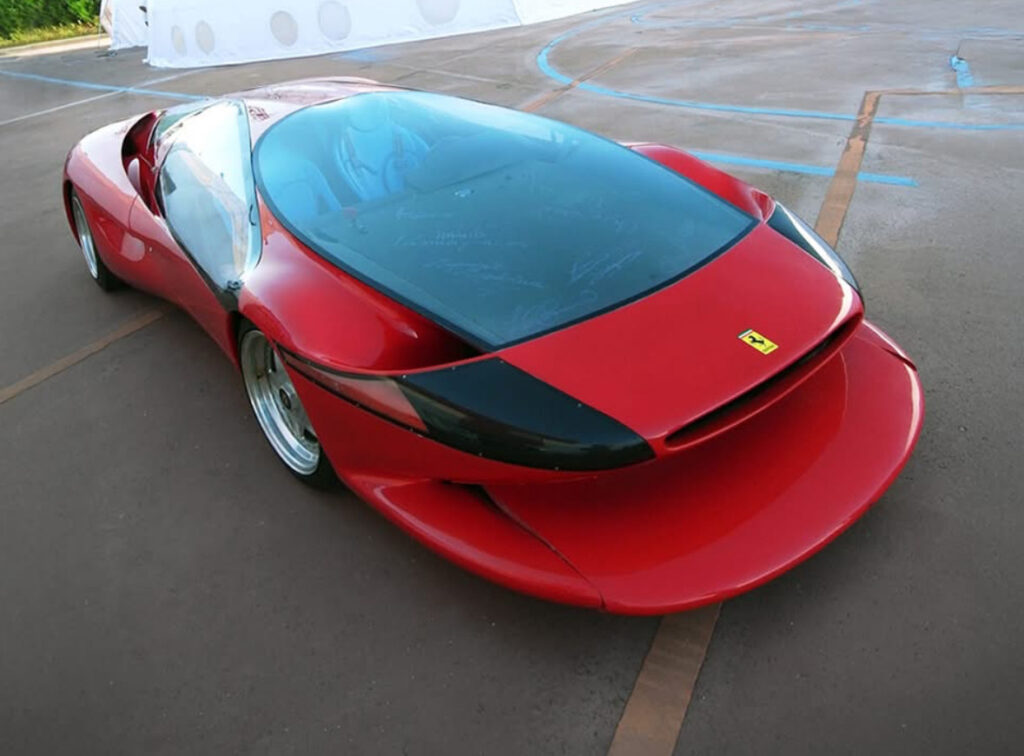In the late 1980s, Luigi Colani, an avant-garde German designer known for his futuristic and biomorphic designs, embarked on an ambitious project to break the land speed record for production supercars. His creation, the Colani Ferrari Testa D’Oro, was a radical reimagining of the Ferrari Testarossa, featuring significant aerodynamic modifications and a twin-turbocharged 12-cylinder engine capable of producing a staggering 750 horsepower.
Though not officially recognized by Ferrari, the Testa D’Oro remains a fascinating anomaly in the world of high-performance cars, blending cutting-edge aerodynamics with raw power. In 1991, it achieved a top speed of 351 km/h (218 mph) at the Bonneville Salt Flats, making it one of the fastest Ferrari-based machines ever built. Today, the Colani Ferrari Testa D’Oro stands as a testament to design experimentation, innovation, and the relentless pursuit of speed.
Luigi Colani: The Man Behind the Machine
A Revolutionary Approach to Design
Before diving into the details of the Testa D’Oro, it is essential to understand Luigi Colani’s design philosophy. Born in 1928 in Berlin, Germany, Colani studied aerodynamics and industrial design, which greatly influenced his approach to automotive and product design. Unlike traditional automotive designers, Colani embraced fluid, organic shapes that mimicked nature, believing that rounded, aerodynamic forms were inherently more efficient and visually appealing.
Colani’s work spanned a wide range of industries, from furniture and cameras to aircraft and automobiles. His creations were controversial and polarizing, with some praising their futuristic appeal while others found them too eccentric. Nevertheless, his philosophy of “biodynamic” design—which prioritized functionality through organic shapes—cemented his reputation as a visionary thinker in industrial design.
Colani and Ferrari: An Unofficial Experiment
The Colani Ferrari Testa D’Oro was not an official Ferrari project but rather an independent reinterpretation of the Ferrari Testarossa. Ferrari, a company deeply rooted in tradition, rarely connected with radical designers like Colani. However, this did not stop him from using the Testarossa as a base platform for his ambitious land speed record attempt.
Partnering with Lotec, a German performance engineering firm, Colani sought to maximize both aerodynamic efficiency and raw power to create a record-breaking supercar.
The Engineering Marvel: Colani Ferrari Testa D’Oro
Aesthetic and Aerodynamic Modifications
Colani’s modifications to the Testarossa were extensive. The boxy, angular lines of the original car were completely reimagined into a smooth, organic shape that reduced drag and improved high-speed stability.
Key Aerodynamic Enhancements:
• Redesigned Front End
• The car’s nose was elongated and reshaped into a rounded, oval form.
• A prominent front splitter was added to generate downforce at high speeds.
• Large air scoops were integrated into the front and sides for brake cooling and engine airflow.
• Bubble-Canopy Windshield
• The windshield was enlarged and curved to minimize air resistance.
• The roofline was streamlined, ensuring a smooth transition of airflow from the front to the rear.
• Extended Rear End & Wheel Covers
• The rear section was elongated to enhance stability at high speeds.
• The rear wheel arches were covered, further reducing aerodynamic drag.
This radical redesign made the Testa D’Oro look nothing like a traditional Ferrari, aligning more closely with Le Mans-style endurance race cars or experimental concept vehicles.
Performance and Powertrain Upgrades
Underneath the revolutionary exterior, the Testa D’Oro housed an extensively modified version of the Testarossa’s 4.9-liter flat-12 engine. The German engineering firm Lotec played a crucial role in enhancing the powertrain.
Performance Highlights:
• Twin-Turbocharged 4.9L Flat-12 Engine
• Originally producing 390 hp in the standard Testarossa, the engine was upgraded to 750 hp.
• Torque output was increased to 600 lb-ft, providing brutal acceleration.
• Top Speed & Acceleration
• Achieved 351 km/h (218 mph) at Bonneville Salt Flats in 1991.
• Estimated 0-60 mph time of around 3.8 seconds.
• Modified Transmission
• To handle the immense power, Lotec reinforced the gearbox and optimized the gear ratios for high-speed performance.
These engineering upgrades positioned the Testa D’Oro as one of the fastest Ferrari-based cars ever built, proving that Colani’s radical approach to aerodynamics and power enhancement was effective.
The Bonneville Land Speed Record Attempt (1991)
In 1991, the Colani Ferrari Testa D’Oro was transported to the Bonneville Salt Flats in Utah, USA, a legendary proving ground for land speed record attempts. The goal was to set a new benchmark for production-based supercars.
Bonneville Speed Week Performance:
• Recorded a top speed of 351 km/h (218 mph)
• Won its class but did not break the overall production car speed record
• Proved the effectiveness of Colani’s aerodynamic modifications
Although it did not claim an outright world record, the Testa D’Oro’s performance validated Colani’s design philosophy and showcased the potential of radical aerodynamics in high-performance applications.
The Legacy of the Colani Ferrari Testa D’Oro
Despite its impressive speed and innovative design, the Testa D’Oro remains one of the lesser-known Ferraris. Unlike the F40 or Enzo, it was never an official Ferrari model, which limited its recognition among mainstream enthusiasts. However, it holds a unique place in automotive history as an experimental masterpiece.
Why the Testa D’Oro Still Matters:
A Testament to Radical Design
• It showcased how aerodynamics could dramatically enhance performance.
• Its futuristic look remains unmatched in the world of Ferrari-based projects.
Proving the Potential of Unconventional Innovation
• Luigi Colani’s biodynamic philosophy was ahead of its time.
• It influenced later designs in high-speed endurance racing and concept cars.
A Rare Collector’s Gem
• Only one unit was built, making it an extremely rare artifact.
• It occasionally appears in automotive museums and exhibitions, sparking interest in Colani’s legacy.
Beyond Cars: Luigi Colani’s Broader Influence
Colani’s work extended far beyond automotive design. His innovative approach influenced multiple industries, including:
• Furniture and industrial design (creating futuristic chairs, desks, and appliances)
• Aircraft and gliders (applying aerodynamic principles to aviation)
• Architecture and urban planning (conceptualizing energy-efficient structures)
His visionary ideas continue to inspire modern designers, proving that bold experimentation and creativity are essential for progress.
A Forgotten Masterpiece of Speed and Innovation
The Colani Ferrari Testa D’Oro remains one of the most intriguing and unique vehicles ever created. It was a bold experiment in aerodynamics, performance, and avant-garde design, demonstrating that breaking conventions often leads to extraordinary results.
Although not widely recognized, the Testa D’Oro stands as a symbol of visionary thinking in automotive engineering. As the industry continues to evolve, with a greater focus on efficiency, aerodynamics, and electric performance, Colani’s radical ideas feel more relevant than ever.
For those who appreciate cutting-edge design and automotive history, the Testa D’Oro is a fascinating piece of engineering excellence, representing the limitless potential of speed, creativity, and forward-thinking innovation.
No comments yet.







